index


I will compare the standard RV Winegard Antenna to the King Jack RV Antenna.
I would not be replacing the Winegard except for the fact that I busted it's mount somehow.
Most have been a branch or something...
And it is advertized as a direct replacement.
Also, when I add more solar panels, the big Winegard will shadow more.
 My trailer is in Chico, Ca.
I picked channel 7 as an arbitrary channel to examine.
Channel 7 is located on Shasta Bally Mt in Redding, about 60 miles away.
My trailer is in Chico, Ca.
I picked channel 7 as an arbitrary channel to examine.
Channel 7 is located on Shasta Bally Mt in Redding, about 60 miles away.
On the left is the Winegard, and on the right is the replacement Jack Antenna.
A casual look at the two antennas shows that the Winegard is not designed for UHF: the dipole element is way too long.
Never the less, it receives UHF digital signals just fine. The Winegard is simply not optimum.
Take a look...
The Winegard signal strength is on the left and the Jack is on the right.
The big Winegard delivers a stronger signal; not only for VHF but also for UHF digital signals.
The Jack only reads 55, and the Winegard reads 59.
But the "size" of the signal does not matter for digital signals.
Here is what is important for digital signals: Quality of the signal.
The Jack does not have as of a strong signal, but it is CLEANER.
The Jack reads 60, and the Winegard reads 50.
Unlike the old analog NTSC signal,
signal strength means nothing. It is all about quality.
Digital signals demand a lot in all the intricate and complicated processing:
absolutely no phase distortion and no differential delay. That is why it is all-or-nothing.
If the logic can figure the signal out,
the picture is perfect! And is as clean and beautiful as can be.
Despite the slight advantage, as you can see the claims of the Jack are over estimated.
It is not THAT much better.
Each antenna picks up about three dozen channels: The Jack picks up 35 channels,
and the Winegard picks up 33 channels.
The difference is in Ch9-4 and Ch9-5, which are solely held by the Jack.
However, channel 33, an analog, looks better on the Winegard.
And it is not surprising; as quality does not matter with analogs.
And by the way...
After 35 years as a Broadcast Engineer, I can tell you WHY the WineGard has terrible distortion, and probably noise too.
It is all about the pattern. At UHF, the WineGard produces a splintered pattern with many fingers on each side.
Many times, I remember the directionality of the big antenna was "wild".
If the Jack is designed correctly, the pattern will be one smooth lobe out in front.
It can be pointed and aligned predictably, and smoothly.
It can see better (with consistency) through trees, and has less distortion.
Also, modern preamps should have less thermal noise, just due to advancements in technology.
I measured the current of the preamp: less than 100 mA. ...And that is easy on my battery budget.
Installation should have taken about 5 minutes.
But the Jack had it's mounting holes drilled about a quarter inch off.
This produced a downward tilt of the antenna of 15 degrees.
Although it looked stupid, I did not think it would make much of a difference in the signal strength.
But it did: about 10%. I was willing to live with the esthetics, but performance... No way!
I took two hours in the blistering heat, between up on the roof and the hardware store,
to change four hole positions. But now, damn it, the antenna sets level.
I could not live with it's nose pointed down.
I would have been the laughing stock of any RV park, as soon
as I raised my mast.

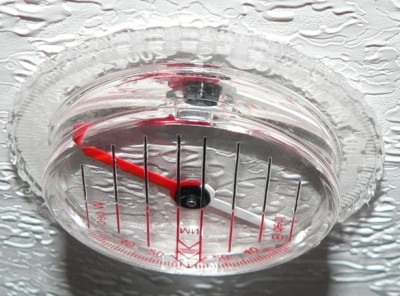 Also, I would like to point out my compass. This compass is mounted up side right, although you see through the bottom.
Also, I would like to point out my compass. This compass is mounted up side right, although you see through the bottom.
The compass must be a "Map" compass that can be placed on a map and be clear to see through.
Also, unlike so many compasses, the North end of the needle needs to me painted on both sides, top and bottom.
They also make another kind of compass, one that mounts on the wall. But I personally can not use that type of compass.
I can not figure it out in my head. I fail to quickly visualize an "above" picture. Call me slow.
I have one in the van, and it is a pain to use and to figure out.
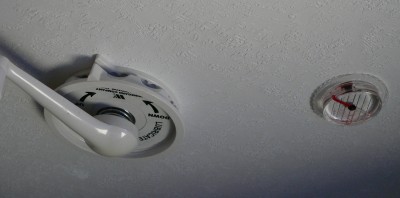 It is mounted on the ceiling next to the antenna crank up. Now I know which way is north.
And I pointed the lines to align with the front of the trailer.
This is also in agreement, as every RVer knows, with the crank which is aligned RV front to RV back.
It is mounted on the ceiling next to the antenna crank up. Now I know which way is north.
And I pointed the lines to align with the front of the trailer.
This is also in agreement, as every RVer knows, with the crank which is aligned RV front to RV back.

 I originally planned for a larger TV to fit in this homemade frame.
The TV is not on a swivel mount, and permanently faces the Coach/Bed.
I originally planned for a larger TV to fit in this homemade frame.
The TV is not on a swivel mount, and permanently faces the Coach/Bed.
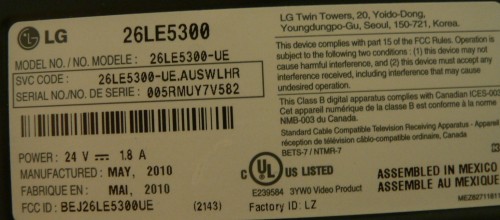 1.8 amps at 24 volts is 4 amps at 12 volts. Which is 5 Amps counting the inverter.
The consumption checks out, and is a good choice for an RV.
At 3 or 4 amps of normal viewing, I can watch TV all night long if I wanted too.
But I really never watch tv at all; Nothing on.
Linda likes it though, or at least to know it is available.
Actually, I sometimes do watch it: to see what the weather is going to do.
I am an Engineer; it was infinitely more fun to build, than to watch.
1.8 amps at 24 volts is 4 amps at 12 volts. Which is 5 Amps counting the inverter.
The consumption checks out, and is a good choice for an RV.
At 3 or 4 amps of normal viewing, I can watch TV all night long if I wanted too.
But I really never watch tv at all; Nothing on.
Linda likes it though, or at least to know it is available.
Actually, I sometimes do watch it: to see what the weather is going to do.
I am an Engineer; it was infinitely more fun to build, than to watch.
 Here is my Soldering Box, and my Engineering help.
Here is my Soldering Box, and my Engineering help.
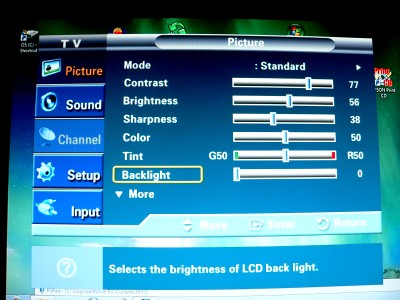 With the BackLight low, the current measures 2.5 amps. But now it is a little too dark for comfortable viewing.
If you are on a current budget, then this is what you need to adjust.
And if you are in bright sunlight, you are out of luck.
With the BackLight low, the current measures 2.5 amps. But now it is a little too dark for comfortable viewing.
If you are on a current budget, then this is what you need to adjust.
And if you are in bright sunlight, you are out of luck.
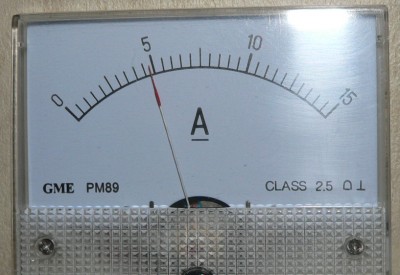 With the BackLight high, and a white picture on the screen, current is 5 amps.
Current goes up and down, with picture content. I have a 400 watt inverter,
and sometimes I can hear the inverter fan come on for a second or two during a bright scene.
It is supposed to add drama to the different scenes.
But I do not need it; I can figure out, on my own, when a scene needs drama.
With the BackLight high, and a white picture on the screen, current is 5 amps.
Current goes up and down, with picture content. I have a 400 watt inverter,
and sometimes I can hear the inverter fan come on for a second or two during a bright scene.
It is supposed to add drama to the different scenes.
But I do not need it; I can figure out, on my own, when a scene needs drama.
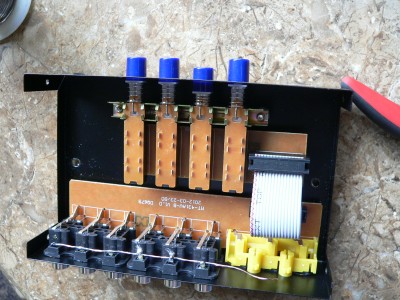 The Audio Selector Box had to be modified from the factory. The factory mistakingly tied all the grounds together from each source.
This is guaranteed to cause ground loops producing hum and other noise during quite periods.
I isolated the inputs and solved the problem.
The Audio Selector Box had to be modified from the factory. The factory mistakingly tied all the grounds together from each source.
This is guaranteed to cause ground loops producing hum and other noise during quite periods.
I isolated the inputs and solved the problem.
The audio amp above, can be ran DC or AC. I normally run it AC, because I set the TV for AC.
It has nice base and treble into two decent size speakers.
Not a lot of power for Acid-Head Rockers,
but clean, high fidelity audio for normal humans, with normal ancestors.

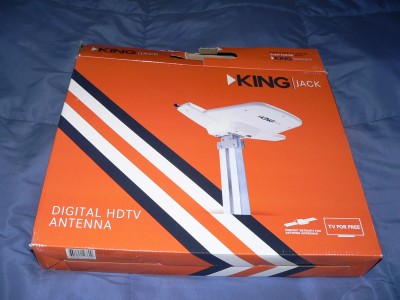

 Also, I would like to point out my compass. This compass is mounted up side right, although you see through the bottom.
Also, I would like to point out my compass. This compass is mounted up side right, although you see through the bottom.
 It is mounted on the ceiling next to the antenna crank up. Now I know which way is north.
And I pointed the lines to align with the front of the trailer.
This is also in agreement, as every RVer knows, with the crank which is aligned RV front to RV back.
It is mounted on the ceiling next to the antenna crank up. Now I know which way is north.
And I pointed the lines to align with the front of the trailer.
This is also in agreement, as every RVer knows, with the crank which is aligned RV front to RV back.
 I originally planned for a larger TV to fit in this homemade frame.
The TV is not on a swivel mount, and permanently faces the Coach/Bed.
I originally planned for a larger TV to fit in this homemade frame.
The TV is not on a swivel mount, and permanently faces the Coach/Bed.
 1.8 amps at 24 volts is 4 amps at 12 volts. Which is 5 Amps counting the inverter.
The consumption checks out, and is a good choice for an RV.
At 3 or 4 amps of normal viewing, I can watch TV all night long if I wanted too.
But I really never watch tv at all; Nothing on.
Linda likes it though, or at least to know it is available.
Actually, I sometimes do watch it: to see what the weather is going to do.
I am an Engineer; it was infinitely more fun to build, than to watch.
1.8 amps at 24 volts is 4 amps at 12 volts. Which is 5 Amps counting the inverter.
The consumption checks out, and is a good choice for an RV.
At 3 or 4 amps of normal viewing, I can watch TV all night long if I wanted too.
But I really never watch tv at all; Nothing on.
Linda likes it though, or at least to know it is available.
Actually, I sometimes do watch it: to see what the weather is going to do.
I am an Engineer; it was infinitely more fun to build, than to watch.
 Here is my Soldering Box, and my Engineering help.
Here is my Soldering Box, and my Engineering help.
 With the BackLight low, the current measures 2.5 amps. But now it is a little too dark for comfortable viewing.
If you are on a current budget, then this is what you need to adjust.
And if you are in bright sunlight, you are out of luck.
With the BackLight low, the current measures 2.5 amps. But now it is a little too dark for comfortable viewing.
If you are on a current budget, then this is what you need to adjust.
And if you are in bright sunlight, you are out of luck.
 With the BackLight high, and a white picture on the screen, current is 5 amps.
Current goes up and down, with picture content. I have a 400 watt inverter,
and sometimes I can hear the inverter fan come on for a second or two during a bright scene.
It is supposed to add drama to the different scenes.
But I do not need it; I can figure out, on my own, when a scene needs drama.
With the BackLight high, and a white picture on the screen, current is 5 amps.
Current goes up and down, with picture content. I have a 400 watt inverter,
and sometimes I can hear the inverter fan come on for a second or two during a bright scene.
It is supposed to add drama to the different scenes.
But I do not need it; I can figure out, on my own, when a scene needs drama.
 The Audio Selector Box had to be modified from the factory. The factory mistakingly tied all the grounds together from each source.
This is guaranteed to cause ground loops producing hum and other noise during quite periods.
I isolated the inputs and solved the problem.
The Audio Selector Box had to be modified from the factory. The factory mistakingly tied all the grounds together from each source.
This is guaranteed to cause ground loops producing hum and other noise during quite periods.
I isolated the inputs and solved the problem.